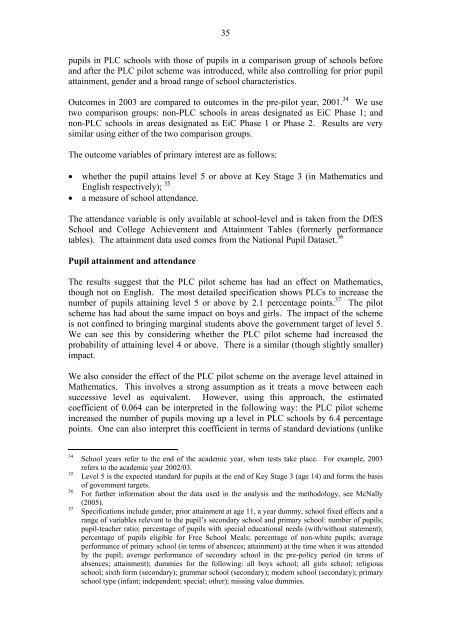Final Report of the Evaluation of the Pupil Learning Credits Pilot ...
Final Report of the Evaluation of the Pupil Learning Credits Pilot ...
Final Report of the Evaluation of the Pupil Learning Credits Pilot ...
Create successful ePaper yourself
Turn your PDF publications into a flip-book with our unique Google optimized e-Paper software.
35<br />
pupils in PLC schools with those <strong>of</strong> pupils in a comparison group <strong>of</strong> schools before<br />
and after <strong>the</strong> PLC pilot scheme was introduced, while also controlling for prior pupil<br />
attainment, gender and a broad range <strong>of</strong> school characteristics.<br />
Outcomes in 2003 are compared to outcomes in <strong>the</strong> pre-pilot year, 2001. 34 We use<br />
two comparison groups: non-PLC schools in areas designated as EiC Phase 1; and<br />
non-PLC schools in areas designated as EiC Phase 1 or Phase 2. Results are very<br />
similar using ei<strong>the</strong>r <strong>of</strong> <strong>the</strong> two comparison groups.<br />
The outcome variables <strong>of</strong> primary interest are as follows:<br />
• whe<strong>the</strong>r <strong>the</strong> pupil attains level 5 or above at Key Stage 3 (in Ma<strong>the</strong>matics and<br />
English respectively); 35<br />
• a measure <strong>of</strong> school attendance.<br />
The attendance variable is only available at school-level and is taken from <strong>the</strong> DfES<br />
School and College Achievement and Attainment Tables (formerly performance<br />
tables). The attainment data used comes from <strong>the</strong> National <strong>Pupil</strong> Dataset. 36<br />
<strong>Pupil</strong> attainment and attendance<br />
The results suggest that <strong>the</strong> PLC pilot scheme has had an effect on Ma<strong>the</strong>matics,<br />
though not on English. The most detailed specification shows PLCs to increase <strong>the</strong><br />
number <strong>of</strong> pupils attaining level 5 or above by 2.1 percentage points. 37 The pilot<br />
scheme has had about <strong>the</strong> same impact on boys and girls. The impact <strong>of</strong> <strong>the</strong> scheme<br />
is not confined to bringing marginal students above <strong>the</strong> government target <strong>of</strong> level 5.<br />
We can see this by considering whe<strong>the</strong>r <strong>the</strong> PLC pilot scheme had increased <strong>the</strong><br />
probability <strong>of</strong> attaining level 4 or above. There is a similar (though slightly smaller)<br />
impact.<br />
We also consider <strong>the</strong> effect <strong>of</strong> <strong>the</strong> PLC pilot scheme on <strong>the</strong> average level attained in<br />
Ma<strong>the</strong>matics. This involves a strong assumption as it treats a move between each<br />
successive level as equivalent. However, using this approach, <strong>the</strong> estimated<br />
coefficient <strong>of</strong> 0.064 can be interpreted in <strong>the</strong> following way: <strong>the</strong> PLC pilot scheme<br />
increased <strong>the</strong> number <strong>of</strong> pupils moving up a level in PLC schools by 6.4 percentage<br />
points. One can also interpret this coefficient in terms <strong>of</strong> standard deviations (unlike<br />
34<br />
35<br />
36<br />
37<br />
School years refer to <strong>the</strong> end <strong>of</strong> <strong>the</strong> academic year, when tests take place. For example, 2003<br />
refers to <strong>the</strong> academic year 2002/03.<br />
Level 5 is <strong>the</strong> expected standard for pupils at <strong>the</strong> end <strong>of</strong> Key Stage 3 (age 14) and forms <strong>the</strong> basis<br />
<strong>of</strong> government targets.<br />
For fur<strong>the</strong>r information about <strong>the</strong> data used in <strong>the</strong> analysis and <strong>the</strong> methodology, see McNally<br />
(2005).<br />
Specifications include gender, prior attainment at age 11, a year dummy, school fixed effects and a<br />
range <strong>of</strong> variables relevant to <strong>the</strong> pupil’s secondary school and primary school: number <strong>of</strong> pupils;<br />
pupil-teacher ratio; percentage <strong>of</strong> pupils with special educational needs (with/without statement);<br />
percentage <strong>of</strong> pupils eligible for Free School Meals; percentage <strong>of</strong> non-white pupils; average<br />
performance <strong>of</strong> primary school (in terms <strong>of</strong> absences; attainment) at <strong>the</strong> time when it was attended<br />
by <strong>the</strong> pupil; average performance <strong>of</strong> secondary school in <strong>the</strong> pre-policy period (in terms <strong>of</strong><br />
absences; attainment); dummies for <strong>the</strong> following: all boys school; all girls school; religious<br />
school; sixth form (secondary); grammar school (secondary); modern school (secondary); primary<br />
school type (infant; independent; special; o<strong>the</strong>r); missing value dummies.

















